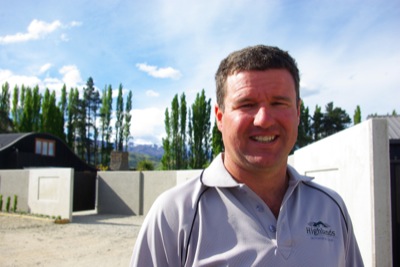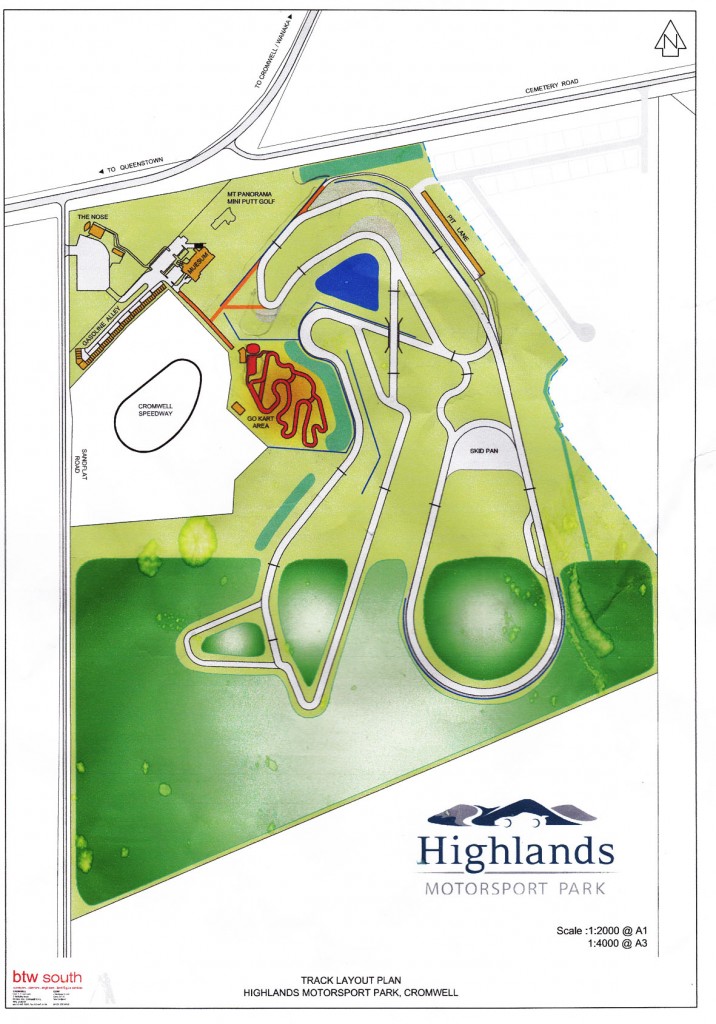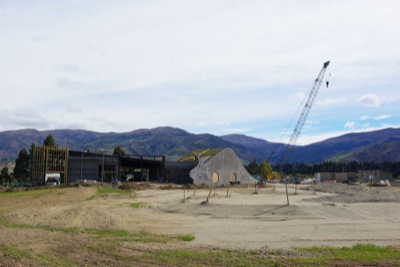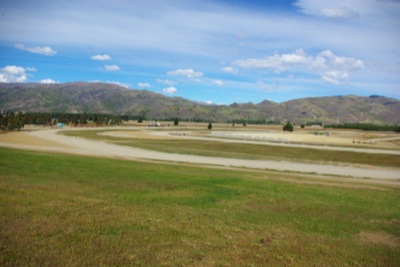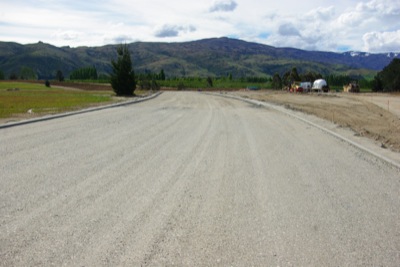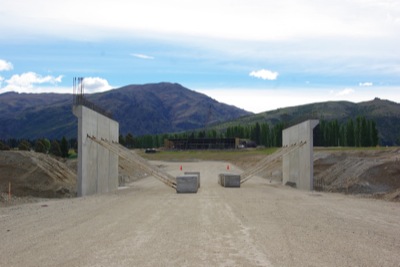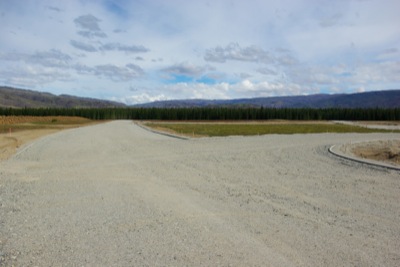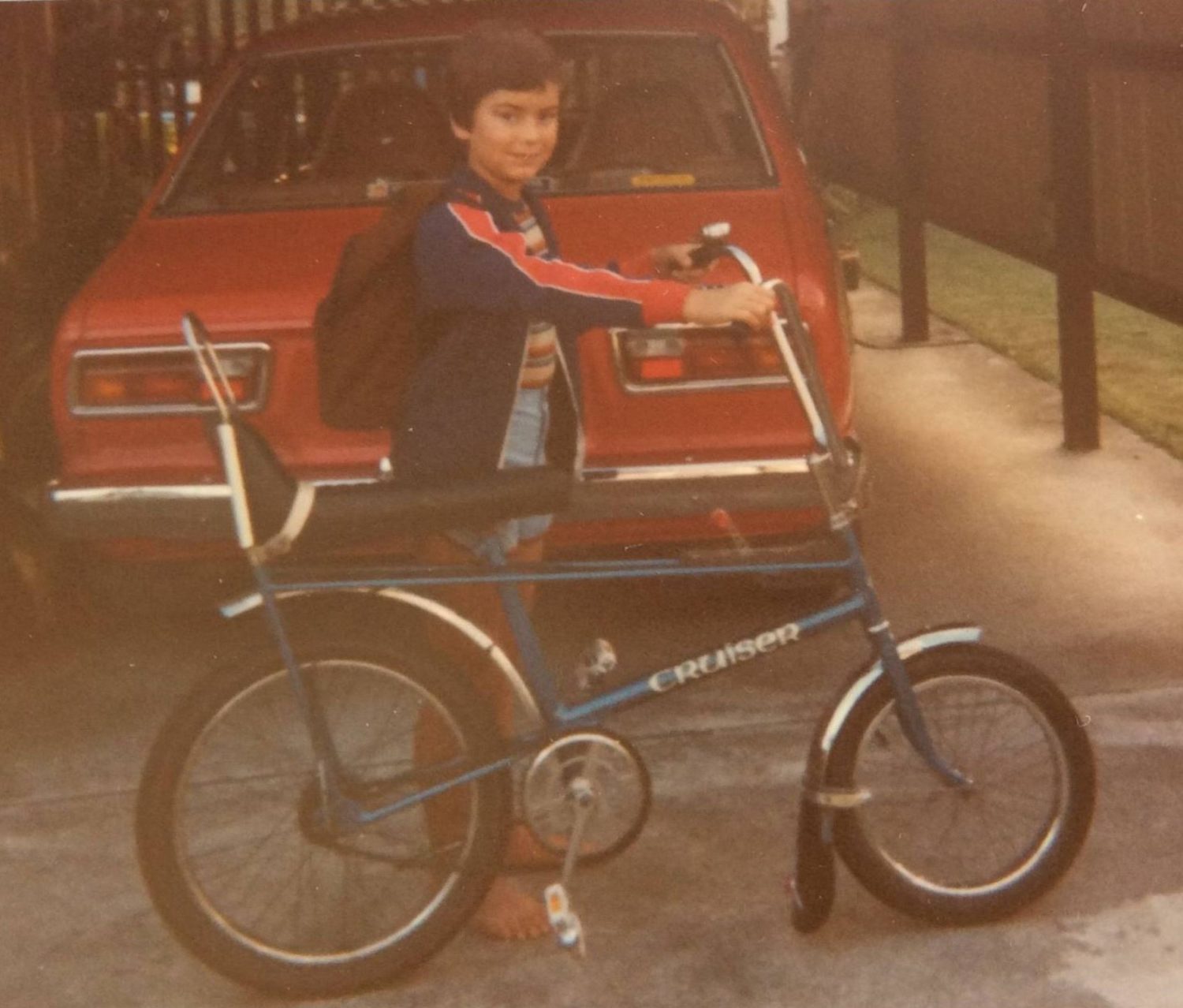The Highlands Motorsport Park project at Cromwell is the most exciting and innovative thing to have happened to New Zealand motorsport since the invention of the wheel. OVERSTEER has been for a look around the track and its facilities
(Please hold cursor over photograph to read the captions)
One of the construction marvels of New Zealand in 2012 will be the completion, before the end of the year, of Highlands Motorsport Park near Cromwell. Highlands is going to set an impossibly high standard for New Zealand motorsport with its 4.5 kilometre circuit, able to be configured into several shorter tracks, all set in landscaped grounds with an artificial lake, museum and club house, cafe, vineyard, 48 covered garages, apartments, and kart track complex all set in the magnificence of Central Otago’s mountain country.
It’s just not the scope of this project that is so incredible — it’s also the speed with which it’s gone from a Great Idea to near completion. It’s helped, of course, that there’s been no difficulty in funding it, but it’s also the vision and the drive of the man behind it.
Tony Quinn is a self-made Scotsman who has made Australia his new home after a spell in New Zealand where he returned to his family roots — pet food. The story of the success of Quinn’s VIP petfood company is a testament to the man’s ability to be able to see what needs to be done and then the energy and tenacity to carry it out.
He’s had a long love affair with fast cars and competition driving and his five wins in the NZ Targa clearly indicate that he’s also got a high level of skill in this area as well.
Those who know Quinn talk about a man who does things his way, he will listen to alternative advice, but he quickly evaluates that and if it doesn’t stack up, he rejects it and gets on with it his way. He doesn’t suffer fools, isn’t afraid of red tape and has little patience for bureaucrats. What’s happening on a dry, sandy area between Cromwell town and the entrance to the Kawarau Gorge that leads to Queenstown, is nothing short of a miracle. But as with everything Tony Quinn does, it’s being done his way, to the highest possible standards and while there’s speculation, almost to the point of bewilderment over what the end game is, you can be sure that Tony Quinn knows exactly what Highlands will be used for.
The concept of a motor racing circuit here was first raised by members of the Queenstown Car Club after local enthusiasts resurrected it following the horrors of the court case that followed the crash that left two dead at the road race there in November 1998.
Queenstown has long been a centre for high-achieving car and motorsport enthusiasts, but the geographic constraints of the area put the lease or purchase of land for a motor racing complex out of reach, so they looked to Cromwell where there was already a well-established stock car circuit adjacent to the land they earmarked.
The Central Otago Council was receptive to the idea as the land was too poor for farming, or grapes, and had been put aside for some sort of recreational activity.
It became obvious that the project was too big for the small club and so it was taken over by four of its members — Jim Boult, Allan Dippie, Ian Begg and Grant Aitken, all men with both a passion for cars and confirmed abilities as drivers.
Work on track design and the concept under which the complex would operate, proceeded well enough and they were able to purchase the freehold of the land from the council.
Cromwell is playing an increasingly important role in the ongoing development of Queenstown, Wanaka and Central Otago as a major playground for tourists and the rich and famous, but what was clear from the start was that this had to be more than another Teretonga, Levels or Ruapuna in the firmament of South Island motor racing circuits. It was obvious that the circuit would have some appeal to the international motor industry manufacturers who used the extensive winter testing facilities at the Snow Farm atop the nearby Crown Range, but they still needed something else. They came up with the idea of a “club” where people with fast cars could garage their vehicles onsite and take them for some fast drives, well away from speed cameras and mobile cash registers. A luxury country club for fast car owners was the idea with motor race meetings almost playing a secondary role.
By early this year, the track layout had been pretty much decided on in general principle and a small vineyard and the former Big Picture Café on the main road had been bought to be part of the completed project.
In the interim, Jim Boult’s share in the company had been bought by Scott O’Donnell and it was decided that a motorsport museum would also be built.
It was expected that construction on the circuit would begin this year. But it also became obvious that to really kick the things along, they needed a cash injection and they went looking for an equity partner.
Enter Tony Quinn. He had been in discussion with Hampton Downs over taking over that complex, but the two parties were a million or two dollars apart.
The Cromwell Four invited Quinn down to have a look, offering him 20 percent of the project.
They showed him around, talked of their ideas and as they walked he listened, asked for more information and finally said he wasn’t interested in a partnership, but he would buy the whole thing.
Within two weeks he had carried out due diligence and he started spending money.
While 20 million is the media figure that’s being bandied about as the cost for completing Highlands, that’s not a figure that’s ever been confirmed by Quinn. But if around $14 million of tax and ratepayers money is being spent on simply upgrading Pukekohe, then 20 million to build a complex as large, as all-encompassing and of such quality as Highlands is a bargain! However, because Quinn believes in buying locally, it’s estimated that since he took over somewhere around six or seven million dollars has been poured into the local economy.
As with much that happens in the South, what was happening at Cromwell was a bit of a mystery to the rest of the country and Quinn quite liked operating under the radar. Local media and motor racing enthusiasts knew, but it wasn’t until Quinn authorised the release of a video showing a helicopter flight over the well-formed circuit that the rest of the country sat up and said “Holy Moly, how’d that happen?”
Since then, “Highlands” has rapidly become part of the New Zealand motor racing lexicon and because it’s in a favourite part of the country, everyone is waiting with high levels of expectation for it to open.
The speed with which Tony Quinn makes decisions and has moved Highlands to the position it is in today is impressive. But if I was to go back in a week’s time, I possibly wouldn’t recognise the place.
Two concrete curbing machines are working on both sides of the track, racing each other to complete their lap. There are hot water moulds producing the cured concrete barriers that will line most of the track and the hot mix plant has been sent down from the North Island, is on site and it’s ready to go as soon as the curbing is finished.
The museum is half built, the foundations are being prepared for the 48 single car garages, an ornamental lake has been created and lined with waterproof clay. Massive, sound-deadening berms have been created and planted with tussock.
The extensive karting track complex is underway and the café and vineyard have been totally refurbished and will be open for business by early November, renamed The Nose.
Mike Sentch has just been named as the manager. Mike’s originally from Auckland but spent several years in Dunedin working for Allan Dippie, building up an MGV8 for him before becoming a landscape gardener. He then moved to Christchurch working for Dennis Chapman before being lured to Australia by Team Kiwi and was involved him the Australian V8 Supercar scene for ten years. Now he’s “back home”.
Tony Quinn wants the project completed by Christmas — so that will happen. But what happens after that is so far only known by Quinn and possibly a handful of people close to him.
The country club and tourist attraction functions are confirmed, testing by manufacturers will almost certainly follow, but there is some mystery over what the 16 days of racing allowed under resource consent will be used for. It will have to be used frugally and well — but that’s a given with Tony Quinn behind it. The circuit will be up to FIA Grade Two, but that doesn’t mean that Motorsport NZ will have any input or involvement with the place at all.
This is a classy place and it will require class acts. Don’t go expecting Tier One or club meetings. Don’t expect the V8 SuperTourers, don’t go expecting the Aussie V8s. Highlands won’t be going to them, instead Highlands will almost certainly be putting on their own acts.
However, you could almost certainly look for at least one meeting featuring the Quinn owned series for GTs that is so successful in Australia with fields filled with some of the world’s fastest and most glamorous cars. Such a meeting would certainly have a high level of appeal to the Queenstown and Wanaka tourist marker as well as the owners of the cars who will make Highlands their “garage”.
Highlands is going to give Aucklanders another reason to visit Central Otago. They already regard Queenstown as their holiday suburb, the Central Otago Rail Trail and an annual destination and Central Otago Pinot Noir as their favourite and most fashionable tipple. Shortly “I took the Lambo to Highlands last week,” will become part of their vocabulary.
Add to that Muscle Car Masters and you will have every V8 loving petrol head in the country wanting to be there.
One of the huge advantages that Highlands will have over every other circuit in the country is weather — OK, the winters can be bleak, but the summers are long, hot — and always dry.
Highlands is not just going to slip into and dovetail with the existing New Zealand motor racing scene — it’s a highly innovative and exciting new direction. And that’s to be applauded.

